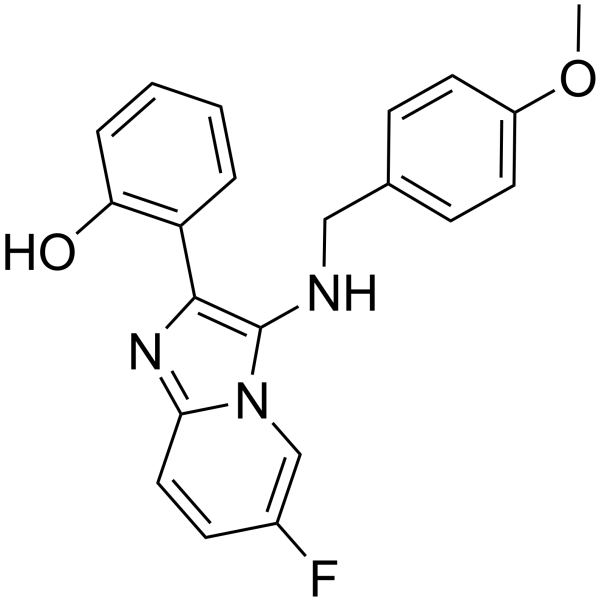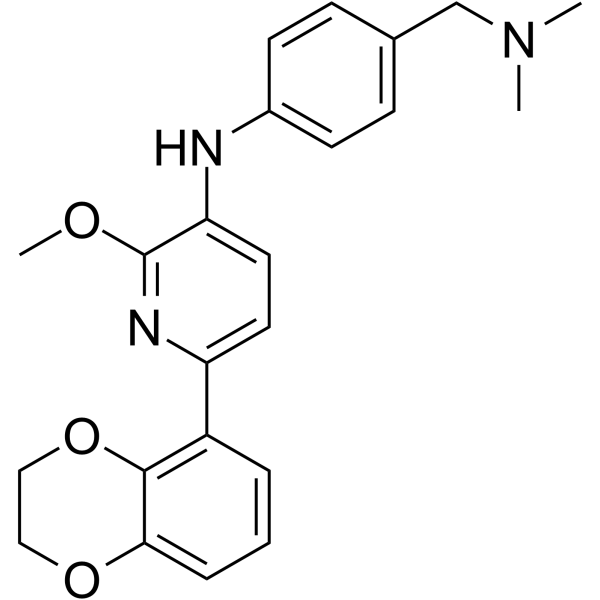- Anti-infection
- Antibody-drug Conjugate/ADC Related
- Apoptosis
- Autophagy
- Cell Cycle/DNA Damage
- Cytoskeleton
- Epigenetics
- GPCR/G Protein
- Immunology/Inflammation
- JAK/STAT Signaling
- MAPK/ERK Pathway
- Membrane Transporter/Ion Channel
- Metabolic Enzyme/Protease
- Neuronal Signaling
- NF-κB
- PI3K/Akt/mTOR
- PROTAC
- Protein Tyrosine Kinase/RTK
- Stem Cell/Wnt
- TGF-beta/Smad
- Vitamin D Related/Nuclear Receptor
- Others
Anti-infection
Apoptosis
Cell Cycle/DNA Damage
Epigenetics
GPCR/G Protein
- 5-HT Receptor
- Adenylate Cyclase
- Adhesion G Protein-coupled Receptors (AGPCRs)
- Adrenergic Receptor
- Amylin Receptor
- Angiotensin Receptor
- Apelin Receptor (APJ)
- Arf Family GTPase
- Arrestin
- Bombesin Receptor
- Bradykinin Receptor
- Cannabinoid Receptor
- CaSR
- CCR
- CGRP Receptor
- Chemerin Receptor
- Cholecystokinin Receptor
- CRFR
- CXCR
- EBI2/GPR183
Immunology/Inflammation
Membrane Transporter/Ion Channel
Metabolic Enzyme/Protease
- 11β-HSD
- 15-PGDH
- 17β-HSD
- 5 alpha Reductase
- Acetolactate Synthase (ALS)
- Acetyl-CoA Carboxylase
- Acetyl-CoA synthetase
- Acyltransferase
- ADAMTS
- Adiponectin Receptor
- Aldehyde Dehydrogenase (ALDH)
- Aldose Reductase
- Amine N-methyltransferase
- Aminoacyl-tRNA Synthetase
- Aminopeptidase
- Aminotransferases (Transaminases)
- Amylases
- Angiotensin-converting Enzyme (ACE)
- ANGPTL
- Apolipoprotein
Neuronal Signaling
Protein Tyrosine Kinase/RTK
Stem Cell/Wnt
- Compound Screening Libraries
- Bioactive Screening Libraries
- •Bioactive Compound Library
- Drug Repurposing Series
- •FDA-Approved Drug Library
- •Drug Repurposing Compound Library
- Natural Products Series
- •Natural Product Library
- •Natural Product-like Compound Library
- Metabolism Series
- •Human Endogenous Metabolite Compound Library
- Disease Related Compound Libraries
- Signaling Pathway Series
- Fragment Libraries
- Diversity Compound Libraries
- •50K Diversity Library
- •5K Scaffold Library
- •3D Diverse Fragment Library
- Virtual Screening
- •50K Virtual Diversity Library
- •10M Virtual Diversity Library
- Recombinant Proteins
- Cytokines and Growth Factors
- Immune Checkpoint Proteins
- CAR-T Related Proteins
- CD Antigens
- Fc Receptors
- Receptor Proteins
- Enzymes & Regulators
- Complement System
- Ubiquitin Related Proteins
- Viral Proteins
- Biotinylated Proteins
- Fluorescent-labeled Recombinant Proteins
- GMP-grade Proteins
- Animal-free Recombinant Proteins
- Protein Expression Service
- Custom Synthesis Service
- ADC-Related Custom Services
- PROTAC-Related Custom Services
- Cytokines and Growth Factors
- Immune Checkpoint Proteins
- CAR-T Related Proteins
- CD Antigens
- Fc Receptors
- Receptor Proteins
- Enzymes & Regulators
- Complement System
- Ubiquitin Related Proteins
- Viral Proteins
- Biotinylated Proteins
- Fluorescent-labeled Recombinant Proteins
- GMP-grade Proteins
- Animal-free Recombinant Proteins
- Others
- View More
CAR-T Related Proteins
- CD27 Ligand/CD70
- CD4
- CD19
- CD27 Ligand/CD70
- CD123
- CD138/Syndecan-1
- Epithelial Cell Adhesion Molecule (EpCAM)
- Folate Receptor 1
- GPC-3
- Guanylate Cyclase 2C
- ErbB2/HER2
- ErbB3/HER3
- c-Met/HGFR
- MSLN
- CA-125
- ROR1
- CEACAM-5
- CD314/NKG2D
- Prostate Specific Membrane Antigen
- CD319/SLAMF7
- TROP-2
- Siglec-6
- Folate Receptor alpha (FR-alpha)
- CD314/NKG2D
- Siglec-3/CD33
- CD27 Ligand/CD70
- CD319/SLAMF7
- ErbB2/HER2
- Siglec-3/CD33
- CD7
- MUC-1/CD227
CD Antigens
- T Cell CD Proteins
- B Cell CD Proteins
- NK Cell CD Proteins
- Macrophage CD Proteins
- Monocyte CD Proteins
- Stem Cell CD Proteins
- Platelet CD Proteins
- Erythrocyte CD Proteins
- Dendritic Cell CD Proteins
- Epithelial cell CD Proteins
- Endothelial cell CD Proteins
- Signal Transduction-related CD Proteins
- Cell Adhesion-related CD Proteins
Receptor Proteins
- Receptor Tyrosine Kinases
- Receptor Serine/Threonine Kinases
- Receptor Tyrosine Phosphatase
- Receptor Guanylyl Cyclase Family
- Cell Adhesion Molecules (CAMs)
- G-Protein-Coupled Receptors (GPCRs)
- Nuclear Receptor Superfamily
- Pattern Recognition Receptors
- Notch family
- Siglec
- Leukocyte Immunoglobin-like Receptors
- Killer-Cell Immunoglobulin-like Receptors
- Cytokine Receptors
Enzymes & Regulators
- Oxidoreductases (EC 1)
- Transferases (EC 2)
- Hydrolases (EC 3)
- Lyases (EC 4)
- Isomerases (EC 5)
- Ligases (EC 6)
- Translocases (EC 7)
- Matrix Metalloproteinases
- ADAMs/ADAMTSs
- Cathepsin
- Carboxypeptidase
- Angiotensin-converting Enzymes
- Caspase
- Carbonic Anhydrase
- Serine/Threonine Kinase Proteins
- Protein Tyrosine Kinases
- Phosphatase
- Topoisomerase
- Protease Inhibitors
- Protein Kinase Inhibitor Peptide (PKI)
- Cyclin-Dependent Kinase Inhibitor Proteins
- Cystatin Family
- Molecular Biology
- •Nucleic Acid Gel Electrophoresis
- •Vector Construction
- •Restriction Endonuclease
- •Materials
- •PCR & qPCR
- •RT-PCR
- •Sequencing
- Protein Biology
- •Protein Sample Preparation
- •Protein Purification
- •Protein Electrophoresis & WB
- •Labeling Kit
- •Multiple Fluorescent Staining
- •Immunoassay
- •Immunoprecipitation Kit
- Cell Biology
- •Cell Culture
- •Cell Analysis
- •3D Cell Culture
- •Cell Isolation
- View More
- Custom Synthesis Service
- Bulk and Custom Synthesis Service
- ADC-Related Custom Services
- PROTAC-Related Custom Services
- Custom Reference Standard Products
- Custom Peptide Synthesis
- Protein Expression Service
- Recombinant Antibody Expression Service
- Protein Crystal Structure Elucidation
- Oligonucleotide Synthesis
- Fluorescent labeling Service
- Custom Synthesis of Stable Isotope-Labeled Compounds
- One-stop CDMO Service
- One-stop Compound Screening Platform
- Virtual Screening
- Molecular dynamics simulation
- Cell-based Compound Screening
- Ion Channel Screening
- Kinase Screening Service
- Surface Plasmon Resonance (SPR) Assay Service
- GPCR Bioassay Screening Services
- Nuclear Receptor Screening Services
- Affinity Mass Spectrometry
- DEL Synthesis and Screening
- Molecular Interaction Assay Service
- Drug Target Identification Service
- AI-Driven Drug Screening
- Molarity Calculator
- Dilution Calculator






























![A2[3]G1 & A2[6]G1 glycan (G1)](http://file.medchemexpress.eu/product_pic/hy-158523.gif)
![FA2[3]G1 & FA2[6]G1 glycan (G1F)](http://file.medchemexpress.eu/product_pic/hy-158473.gif)
















![FA2[3]G1 & FA2[6]G1 glycan (G1F), procainamide labelled](http://file.medchemexpress.eu/product_pic/hy-158480.gif)
![FA2[3]G1 & FA2[6]G1 glycan (G1F), APTS labelled](http://file.medchemexpress.eu/product_pic/hy-158479.gif)








![A2[3]G1 & A2[6]G1 glycan (G1), 2-AA labelled](http://file.medchemexpress.eu/product_pic/hy-158520.gif)




![FA2[3]G1 & FA2[6]G1 glycan (G1F), 2-AA labelled](http://file.medchemexpress.eu/product_pic/hy-158481.gif)
![FA2[3]G1 & FA2[6]G1 glycan (G1F), 2-AB labelled](http://file.medchemexpress.eu/product_pic/hy-158478.gif)

















































![A2[3]G1 & A2[6]G1 glycan (G1), 2-AB labelled](http://file.medchemexpress.eu/product_pic/hy-158522.gif)


















































![[Val4] Angiotensin III](http://file.medchemexpress.eu/product_pic/hy-p3910.gif)














































































































































































































































































![7H-Dibenzo[c,g]carbazole](http://file.medchemexpress.eu/product_pic/hy-119983.gif)






















![A2[3]G1F1(α-1-3) glycan](http://file.medchemexpress.eu/product_pic/hy-158458.gif)








































![A2[3]G1 N-glycan](http://file.medchemexpress.eu/product_pic/hy-158457.gif)









































![Benz[g]isoquinoline-5,10-dione](http://file.medchemexpress.eu/product_pic/hy-w320538.gif)



![NH2-c[X-R-L-S-X]-K-G-P-(D-1Nal)](http://file.medchemexpress.eu/product_pic/hy-p3346.gif)






![NH2-c[X-R-L-S-X]-K-G-P-(D-2Nal)](http://file.medchemexpress.eu/product_pic/hy-p3347.gif)

















![1,7-Dimethyl-1H-imidazo[4,5-g]quinoxalin-2-amine-d3](http://file.medchemexpress.eu/product_pic/hy-132833s.gif)






















![2-(1-Hydroxy-1-methylethyl)-4-methoxyfuro-[3,2-g]benzopyran-7-one](http://file.medchemexpress.eu/product_pic/hy-n2679.gif)






























































![FA2[3]BG1 & FA2[6]BG1 glycan (G1B), 2-AA labelled](http://file.medchemexpress.eu/product_pic/hy-158455.gif)
![FA2[3]BG1 & FA2[6]BG1 glycan (G1B), 2-AB labelled](http://file.medchemexpress.eu/product_pic/hy-158456.gif)




































































































































![[Gly9-OH]-Atosiban](http://file.medchemexpress.eu/product_pic/hy-p4897.gif)



![[1,1′:4′,1′′-Terphenyl]-3,4′′,5-triol](http://file.medchemexpress.eu/product_pic/hy-120654.gif)






























































































































































![N-[3-(2-Furyl)acryloyl]-Phe-Gly-Gly](http://file.medchemexpress.eu/product_pic/hy-w010991.gif)































































![[Pyr1]-Apelin-13, Gly(15N) TFA](http://file.medchemexpress.eu/product_pic/hy-p1033s.gif)




















































































































![Ac-Pro-Leu-Gly-[(S)-2-mercapto-4-methyl-pentanoyl]-Leu-Gly-OEt](http://file.medchemexpress.eu/product_pic/hy-p4521.gif)


















































































































































































































































































































































































































































































































![N-[2-(Fmoc-amino)-ethyl]-Gly-O-tBu hydrochloride](http://file.medchemexpress.eu/product_pic/hy-w141923.gif)













































2](http://file.medchemexpress.eu/product_pic/hy-158117.gif)

































































































































































































































![[Gly11] Substance P](http://file.medchemexpress.eu/product_pic/hy-p3922.gif)

















































![Cyclo[Arg-Gly-Asp-D-Phe-Lys(Azide)]](http://file.medchemexpress.eu/product_pic/hy-p10303.gif)






















































































































































































































































































![[Arg-15,20,21,Leu17]-PACAP-Gly-Lys-Arg-NH2](http://file.medchemexpress.eu/product_pic/hy-p3875.gif)




























































































![2F-Pyrimidine-piperidine-spiro[3.3]heptane-acid](http://file.medchemexpress.eu/product_pic/hy-169489.gif)







































































































































































![[Lys8, Lys9]-Neurotensin (8-13)](http://file.medchemexpress.eu/product_pic/hy-p2544.gif)











































































































































































































































































































































































































![[Leu15]-Gastrin I (human)](http://file.medchemexpress.eu/product_pic/hy-p2671.gif)

















































































































































































































































![[D-Arg1,D-Phe5,D-Trp7,9,Leu11]-Substance P](http://file.medchemexpress.eu/product_pic/hy-103544.gif)





